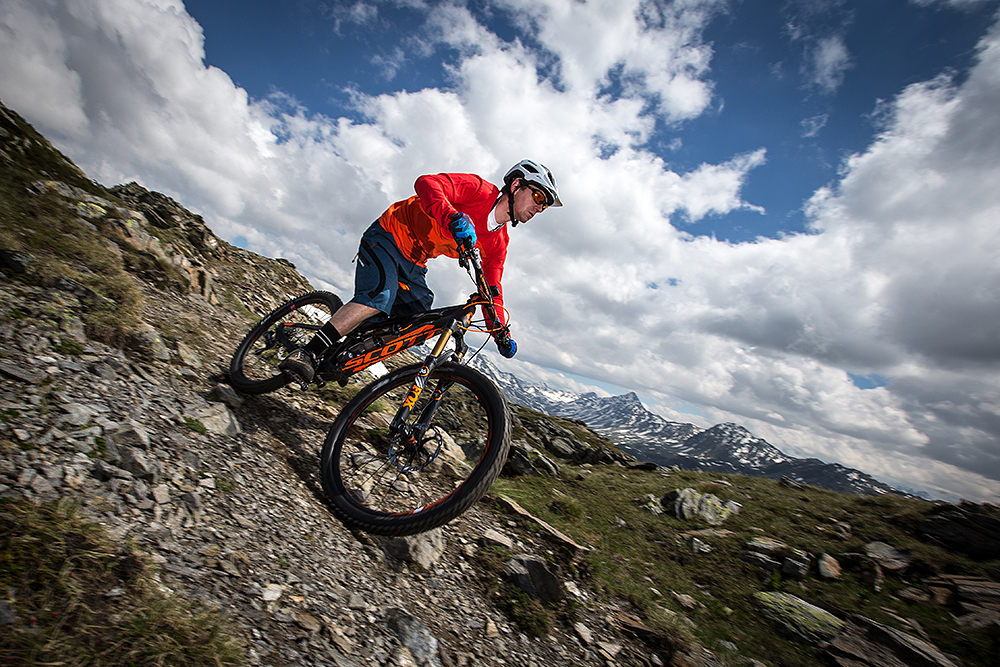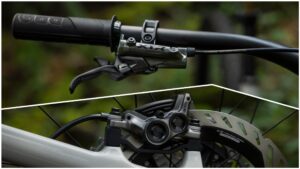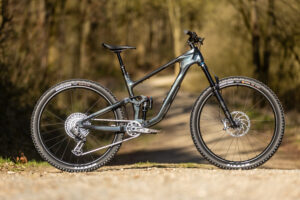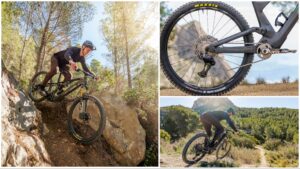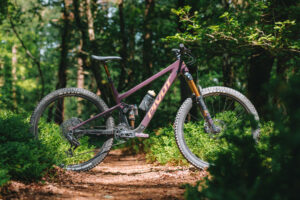Schwalbe's Procore design claims to give you more grip with less punctures. Sounds like heaven, but can the system really deliver? We spend a day putting it through its paces.
First Ride: Schwalbe Procore dual chamber system
What is the Schwalbe Procore system?
Stripped back to basics, the Schwalbe Procore system is a small volume tube, inflated to very high pressure, that pushes the bead of the tyre against the sidewall of the rim. Run in conjunction with a tubeless tyre and sealant, the void around the outside of the Procore tube can be run at much lower pressures, giving superb comfort and traction without the risk of pinch-flats or burping the tyre under hard cornering.

One valve inflates the tubeless tyre, the other regulates the Procore tube. Valves should be opposite on the rim, these ones are adjacent for photo purposes
What kind of pressures are we talking about here?
The Schwalbe guys set up our bike (a Scott Genius LT 700 Tuned with Syncros AM1.5 rims and Schwalbe Hans Dampf Evo 2.35in tyres) with 60psi in the Procore and 17.5psi front/19psi rear in the tyre. The pressure range for the Procore system is 55-85psi, whereas the tyre itself (outer chamber) can be run as low as 14psi.
What else do I need to know?
It may have started out as a joint development with German component manufacturer Syntace, but the finished product will be solely branded Schwalbe. It will be sold as a kit, with two Procore tubes, valves and possibly rim tape, tyre levers and sealant for around €150. Availability should be early 2015.
The Procore system will be compatible with any rim over 23mm internal width and any tubeless ready tyre, but discussions are ongoing with rim manufacturers regarding the extra valve hole needed, and stresses produced by the high pressure of the Procore tube. It goes without saying that many people will be retrofitting the system to their existing wheels, and drilling their own valve holes, whatever the consequences, but if you have a carbon wheel the risks of failure are much greater, so caution is advised.
According to Schwalbe, the cross-section of Procore is round, but we still don’t know exactly what it’s made out of and how the second valve gets air into the outer chamber. Speculation is that the tube fits to the side, or around the valve, but Schwalbe will only reveal that this part of the development process was one of the most difficult to resolve.
In the unlikely event of the Procore puncturing, the air will escape into the outer chamber, but the additional volume will easily accomodates this without any risk of the tyre blowing off the rim. Likewise, if the outer chamber punctures, the tyre will remain on the rim instead of flapping around (like Aaron Gwin’s at Leogang) and you can even ride on the flat tyre thanks to the high pressure in the Procore.
Finally, we now know the system adds around 200g per wheel. But Schwalbe say that this can be offset by using lighter casing tyres (instead of dual ply) and lighter rims. Taking this into account, the weight gain can be as low as 50g per wheel.
Has it been proven in competition?
Nico Lau won the Peebles round of the Enduro World Series using the system, backed up a week later by Emmeline Ragot taking first place at the Fort William Downhill World Cup and Sam Hill securing second. Fort William being an infamously tough track on rims and tyres, and one on which both Rachel Atherton and Manon Carpenter punctured this year, when they were up on Ragot’s split times.
So come on then, is it any good?
It’s not just good, it’s amazing. Obviously this is not a definitive review, having ridden it for only 16-miles in the mountains above Davos, in Switzerland, but the terrain was certainly challenging, and littered with enough rocks to allow us to experience the benefits. What we didn’t get to do was look inside, or have a crack at fitting them, and the only way to test what kind of reduction in flats you can expect is to run them for a good few months on a variety of terrain.
The overwhelming impression we went away with was one of massively increased traction. With a larger contact patch and pliable casing, that would deform like putty to the surface of the trail, we found we could crawl up ridiculously steep climbs, despite being covered in roots and rocks. Even on fireroads, other riders would spin their wheels and kick up dust, while our Procore tyres just drove their knobs into the dirt.
Braking traction is greatly improved, and the tread has less of a tendancy to slide when cornering. Indeed, the day before we’d been riding the same Hans Dampf tyre at 28psi and drifting on almost every corner. It’s more comfortable too, like having the most supple suspension system on the market. But there’s a progression as the tyre compresses, so although it’s easy to squeeze at first, it quickly firms up.
Perhaps the most dramatic transformation, though, was to our mindset. We threw caution to the wind, opting for jagged, toothy line choices that were not only faster and more direct but more fun. Of course, they came with a significantly higher risk of punctures, but with Procore it just didn’t matter anymore. Land in a pile of rocks? Why not? Huck over that big boulder blocking the trail? Easy… It really was like cheating.
It’s true that we could feel the sidewall rolling a bit more than normal, but remember that 20psi in the outer chamber with Procore is not the same as 20psi in a tubeless tyre, because the volume is much smaller. And with the additional support of the Procore at the bead, the tyre remains a lot more stable than we expected. Of course you can always increase the pressure if you’re riding bike park trails with high-speed g-outs and berms and begin feeling too much flex in the tyre.
Needless to say we didn’t puncure, despite aiming our wheels at every rock on the mountain. In fact the worst part of the whole experience was having to give it back.
Expect more details to be released at Eurobike at the end of August, and a full test in MBR as soon as we get samples.
Verdict
This is only a first ride, and we've yet to install the system with a variety of tyres and rims, but first impressions are that this could be a real game-changing product.






